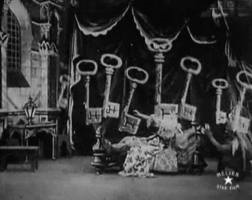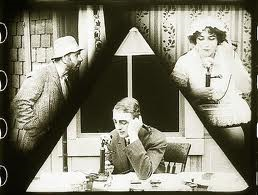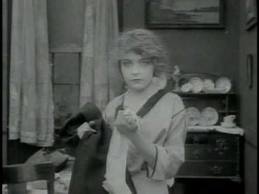Posted by Sarah
This week we had the opportunity to compare some varied short film melodramas: Barbe-bleue (Bluebeard, 1901, 10 mins) directed by and starring George Melies, The Mothering Heart (1913, 22 mins) directed by D.W. Griffith and starring his frequent collaborator Lillian Gish and Suspense (1913, 10 mins) co-directed by, and starring, Lois Weber. I have summarised the discussion below, but do log in to comment or email me on sp458@kent.ac.uk to add your thoughts.
 Discussion on the earliest of these film shorts, Barbe-bleue, noted that, in keeping with other films produced at the time, it was filmed by a static camera. However, the fairly frequent set changes and constant on-screen action (including some of Melies’ trademark trick shots of a character – a taunting imp – appearing and disappearing accompanied by a puff of smoke) added impetus to the already melodramatic story. This story was closely related to the gothic with some powerful imagery involving a secret room, keys, Bluebeard’s dead wives hanging from nooses and the latter characters invading his current wife’s dreams. Significantly the narrative centred on a woman (or perhaps more correctly women) in peril, which has been a constant theme in the films the Melodrama Research Group has screened. Appropriately for Melies, known for his magic, Bluebeard’s dead wives inexplicably become reanimated, just in time to be rescued by men who had rather magically appeared.
Discussion on the earliest of these film shorts, Barbe-bleue, noted that, in keeping with other films produced at the time, it was filmed by a static camera. However, the fairly frequent set changes and constant on-screen action (including some of Melies’ trademark trick shots of a character – a taunting imp – appearing and disappearing accompanied by a puff of smoke) added impetus to the already melodramatic story. This story was closely related to the gothic with some powerful imagery involving a secret room, keys, Bluebeard’s dead wives hanging from nooses and the latter characters invading his current wife’s dreams. Significantly the narrative centred on a woman (or perhaps more correctly women) in peril, which has been a constant theme in the films the Melodrama Research Group has screened. Appropriately for Melies, known for his magic, Bluebeard’s dead wives inexplicably become reanimated, just in time to be rescued by men who had rather magically appeared.
 Like Barbe-bleue, Suspense bore close relation to the gothic since they both focus on a woman in jeopardy. The threat to the woman in Suspense is explicitly sexual, however. Tom Gunning’s article on the use of telephone in early film “Heard over the phone: The Lonely Villa and the de Lorde tradition of the terrors of technology.” Screen 32.2 (1991): 184-196 was referenced. In this, Gunning notes the fact that both telephonic and cinematic technology manage to bring us near to, but at the same time keep us at a distance from, the subject (either the person at the other end of the telephone, or the characters in the film). We are not in a position to affect what occurs onscreen, while the husband in Suspense is similarly hamstrung by his physical distance from his home and wife whilst they are under attack. It was noted that Gunning mentions D.W. Griffith’s Lonely Villa (1909) which also uses a telephone in the narrative.
Like Barbe-bleue, Suspense bore close relation to the gothic since they both focus on a woman in jeopardy. The threat to the woman in Suspense is explicitly sexual, however. Tom Gunning’s article on the use of telephone in early film “Heard over the phone: The Lonely Villa and the de Lorde tradition of the terrors of technology.” Screen 32.2 (1991): 184-196 was referenced. In this, Gunning notes the fact that both telephonic and cinematic technology manage to bring us near to, but at the same time keep us at a distance from, the subject (either the person at the other end of the telephone, or the characters in the film). We are not in a position to affect what occurs onscreen, while the husband in Suspense is similarly hamstrung by his physical distance from his home and wife whilst they are under attack. It was noted that Gunning mentions D.W. Griffith’s Lonely Villa (1909) which also uses a telephone in the narrative.
As well as an exciting narrative, Suspense included some stunning shots. Especially striking were those from a character’s point of view. One of these was a shot from above of the tramp looking up and threatening the woman, supposedly from the woman’s point of view out of an upstairs window. In addition, the tramp was shown to be particularly menacing as he ascend the stairs and looms large in the frame. The split screen which sectioned the tramp, the husband and the wife into separate areas was also very effective. The car chase afforded some great opportunities for inventive camerawork. There was a point-of-view shot from the second car of the first, while the wing mirror of the first car neatly showed those pursuing it several times.
D.W. Griffith’s The Mothering Heart was very different to both Barbe-bleue and Suspense. The melodrama focused on the less fantastical, and arguably less suspenseful, issues of marriage and infidelity. It was preoccupied, as were other films of the time, with the split of the woman into virgin (as represented by Lillian Gish) and the vamp (Viola Barry). Both of whom were interested in the same man (Walter Miller). Discussion of Griffith’s film focused mainly on the presence of Lillian Gish and the similarity of her role to the one she played in Griffith’s Way Down East (1920) in which she also appeared as a mother who tragically lost her baby. While Gish’s character here appeared to act more progressively than in Way Down East – she leaves her husband while she is pregnant due to his infidelity – the reconciliation at the end over their dead baby’s body felt very contrived. Griffith’s inclusion of Apache dancing taking place in the background of the club where the husband meets the vamp was also commented upon. A comparison was drawn between the Apache woman following her man and the foregrounding of suffering Woman – a common theme of melodrama.
It was also especially interesting to compare the work of two often-referenced male film pioneers (Melies and Griffith) with a lesser known, though hugely important, female director of the silent era.


Posted by Sarah
Thank you Frances, for your really interesting comments. I thought it was especially useful how you’ve compared Suspense to Barbe-Bleue, and also the latter to other Melies films.
A thought that just occurred to me. How does the delay of revelations fit in with melodrama more generally, rather than the subset (subgenre?….) of gothic films? Can we reconcile the arguably ‘over the top’ nature of melodrama with such reticence, even if it does enable the big reveal? Or does such suspense increase the melodrama?
Apologies that this vague notion is far less thought through than yours!
Posted by Frances
Thanks Sarah for this and I think this question concerning the ‘over the top’ nature of melodrama and the delayed reveal tactics used in Barbe-Bleue is really interesting! This question actually reminds me a lot of the discussion we had after viewing Snow White. It was noted then that the Evil Queen conforms to some of the archetypes of melodrama’s villains (particularly from the stage) and I think the way her transformation and death are represented in the film fits quite well with this question of narrative and visual reticence. And in both cases the tension between what we are shown and what is hidden certainly adds to the melodramatic nature of the film.
In the transformation scene (when the Evil Queen becomes the Witch) a big emphasis is placed upon the horror of the mutation which, for the most part, is shown to us and we are encouraged to look. Indeed at one point the Queen provides a direct instruction to do this, saying “look, my hands!” and the image correspondingly shows her fingers aging and contorting. Yet these shots revealing the Queen’s transformation are only fragments (her hands, hair, voice etc.). It is once the change is complete that she is revealed to us as a whole and here we again experience a temporary delay similar to Barbe-Bleue: she is shown in shadow first and then her arm covers her face before the ‘big reveal’. The camera zooms towards the Queen/Witch as she reveals her new face so our act of looking is again emphasised and the consequence of this look is also dramatized (the crow recoils away in horror).
The Witch’s death, however, reverses this principle. When she finally falls from the cliff we do not see her demise in full and the music which had been playing during the previous pursuit with the dwarves stops. The film cuts back to the vultures sitting in a nearby tree which again stresses this denied revelation: the use of the birds provides a nice comparison to the crow in the earlier scene except in this instance the vultures see what we cannot. Arguably the melodrama of Snow White peaks in this portion of the film (Snow White’s poisoning, the Queen’s death, the mourning of the dwarves and rescue by the Prince) so it is intriguing how this key moment is portrayed not through a delayed reveal but rather the visual revelation of this dramatic death is denied altogether.
Posted by Sarah
Thanks Frances, for a really useful reference back to another film we’ve recently screened. I’m particularly intrigued by the fact that in Snow White the Witch’s death most relates to this notion of restraint.
The withholding of information and visuals are clearly used in melodrama more generally, as well as the gothic. I do wonder if this is more prevalent in those films we might categorise as gothic, though. I imagine that it goes rather well with the theme of secrets which, while it is also present in melodrama, arguably plays a more central role in the gothic.
Do you think the reticence is on the whole more prevalent in the gothic than perhaps melodrama more generally? And what might the consequences of this be…….? (I’m asking you rather than proffering my own opinion as you are far more versed in the gothic than I am!)
Posted by Frances
Thanks for this Sarah and for raising another intriguing question! I think the proposal that reticence is present in those melodramas which are also classed as gothic is a very valid one. This does tie in well with the predominant themes of the gothic (hidden spaces and secrets, etc.) and the manner in which Barbe-Bleue transforms these narrative tropes into a stylistic choice (the darkness temporally shielding the horrific reveal) is certainly echoed in later gothic films. One need only look at the use of light and shadow in the delayed revelation of the secret room in Secret Beyond the Door (1947) – a key text in the Hollywood 1940s cycle of gothic films – to see a similar use of visuals!
I think the answer to your query also comes back to the ultimate question we ask ourselves every week: what is a melodrama? We have commented on several occasions how the melodramas discussed so far feature the suffering of the main protagonist/s (often a woman but not always) at the core of the narrative and this of course resonates strongly with the gothic tradition of the ‘woman-in-jeopardy’. But the use of narrative and visual reticence in addition to this in the melodramas we have seen may also relate more generally to the other genres and traditions at work in these films: for example, the fairy-tale in Snow White, the folktale in Barbe-Bleue, the gothic in Gaslight and, as I am sure we will discuss next week, horror in Poltergeist. So another way of phrasing the question is: if reticence is common in some of the films we have watched, does this mean it is a generic trope for melodrama, or is it a narrative/aesthetic device to enhance the melodramatic qualities of otherwise distinct genre films (or films pertaining to other generic traditions as well)?
Posted by Sarah
Thanks again, Frances. Indeed, we do always return to asking ‘what is melodrama?’ Although, as I think we’ve said, other questions, perhaps easier (!) to answer, are ‘what is not melodrama?’ and ‘what is melodrama not?’ Given the general pervasiveness of melodrama, as well as its infinite variety, this might enable us to narrow things down a little!
But getting back to the fascinating point you raise, it may well be significant that the films you’ve just cited (Snow White and Barbe-Bleue) do perhaps fit less snugly within the melodrama genre. or at least bear close relation to other genres. But that the gothic aspects of both these films (maybe especially aided by their gestures towards reticence) increase the sense that they are melodramatic: the appeal to the gothic rather than melodrama per se is what gives the impression of melodrama.
You may have noticed that I haven’t really answered your brilliant question! (Though I’m inclined to agree with the latter part – that reticence is not necessarily inherent in melodrama, but rather allows for an aspect of the melodramatic to be emphasised. Or might it just be that some melodramas employ it, while others don’t?). It’s certainly worth further investigation. And I would definitely be happy to foreground the gothic in some of our screenings…..
Posted by Frances
Thanks for such a thorough summary Sarah! I have another thought to add concerning the suspenseful nature of the first two shorts (Suspense and Barbe-bleue): I think it is also interesting how narrative information is conveyed in these films, particularly during the films’ climatic moments. The split-screen in Suspense of course functions to emphasise the dramatic tension, collapsing the space between the various characters and their geographical locations during the attempted attack, cries for help and ride to the rescue. In this sense all the narrative components are revealed simultaneously to the viewer, increasing the tension of the scene.
Barbe-bleue is quite different in this respect. Rather than reveal all the action immediately to the viewer during one of the film’s climatic moments, as Suspense does, Barbe-bleue withholds this information temporally. But the effect is equally suspenseful. When the new bride enters the locked chamber for the first time, the reveal of the room’s grisly secret is not immediately shown: the young wife stumbles into the dark searching for the window’s shutters and indistinguishable sacks can be seen in the background. It is only when the light from the window enters the room that this background is given form as the hanging bodies of Bluebeard’s previous wives. This moment of horror is further stressed by the unique position it possesses within Melies’ oeuvre: Melies’ other works at this time place enormous emphasis on what the viewer can see in order to marvel at the sophistication of the special effects on display. Melies’ films are certainly a type of “exhibitionist cinema” identified as part of the “cinema of attractions” model (Gunning, 2006). Therefore the delayed reveal in Barbe-bleue provides a significant contrast to both the representation of events in Suspense and other films by Melies.
It is interesting to see how such different cinematic techniques can contribute to a comparable result: in this case, the melodramatic (and gothic) nature of the films!
Gunning, T. 2006 (1986). “The Cinema of Attraction[s]: Early Film, Its Spectator and the Avant-Garde”. In: Strauven, W. (ed.) The Cinema of Attractions Reloaded. Amsterdam: Amsterdamn University Press.